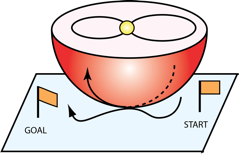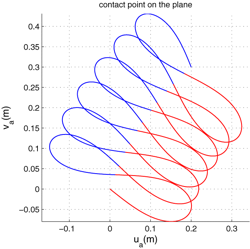Motion Planning for Rolling Systems
Recently, there has been a growing interest to robotic systems where non-holonomic rolling constraints are used not only for manipulation but also for locomotion. In such systems self-propelled movements are usually generated by creating imbalance and changing the system’s inertia. These vehicles can be useful when the usage of traditional machines is limited or undesirable. While the motions of spherical rolling robots appear aesthetically beautiful, it is far from being clear how these versatile motions can be planned and implemented in the full state space when the dynamics of the actuators is taken into account.
We conducted an analysis of the motion planning problem for a ball-plate system with a limited contact area. To solve this problem, we have proposed a technique, based on tracing the asymmetric spherical figure-eight, which produces a desired displacement of the ball on the contact plane. To construct smooth trajectories, we designed a generalized Viviani curve resulting in Euler’s elastica curves in the contact place (see Fig. 4), and showed how it can be implemented in motion planning. I have also designed a spherical rolling robot actuated by internal rotors, and developed an iterative steering technique, based on the nilpotent approximation of the robot dynamics.
Fig.4. Motivating example (left), motion planning problem for the center of gravity on the main hemisphere plane (middle), and a sub-optimal trajectory on the contact plane (right).
We have sketched several working ideas, based on the geometric control theory, about how new motion strategies would be constructed for different (and more efficient than internal rotors) types of actuation systems. In addition to the geometric control strategies, we explore alternative control principles and biologically-inspired approaches to the construction of versatile motion gaits. One of the approaches worth looking at is to select several gait patterns—motion primitives mimicking the dynamics of the rolling robot—and blend them under a central pattern generator. We also plan to explore prospects of miniaturization, and outline possible scenarios of cooperative motions for a swarm of rolling robots.


